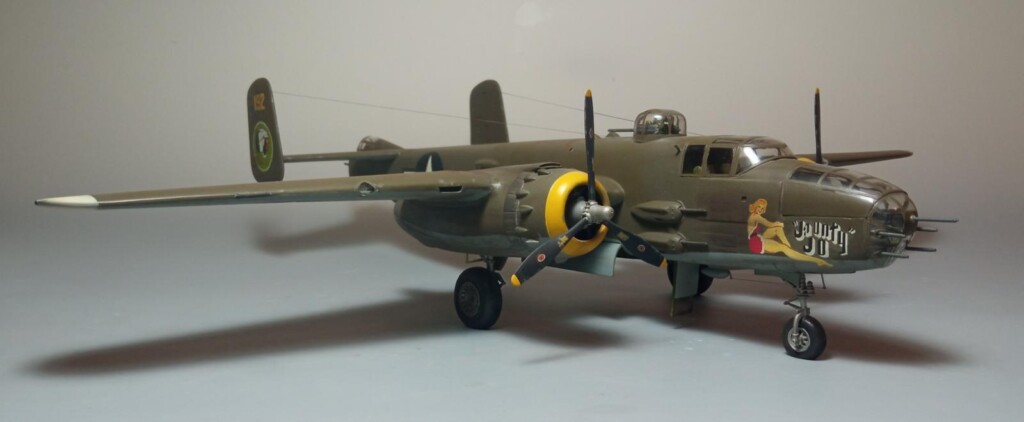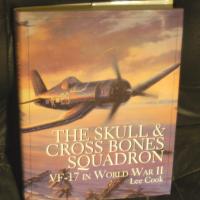Monogram 1/48 B-25J Mitchell
The 498th Bombardment Squadron was first organized at Columbia Army Air Base, South Carolina, in September 1942, as one of the four original squadrons of the 345th Bombardment Group. Upon finishing training with B-25 Mitchells, the squadron departed for the Southwest Pacific Theater in April 1943, reaching its combat station near Port Moresby, New Guinea in early June.
Starting flying combat missions at the end of June, the squadron operated from New Guinea until July 1944. Missions included bombing and strafing Japanese installations in New Guinea and the Bismarck Archipelago, attacking enemy shipping in sealanes within their B-25s range, performing air support (including airdropping supplies) for ground units in the Admiralty Islands and, finally carrying out courier and aerial reconnaissance missions.
On 2 November 1943, the squadron flew a series of unescorted attacks on flak positions, coastal defenses and barracks at Rabaul IJN base, earning a Distinguished Unit Citation. In July 1944 it moved to Biak Island in the Netherlands East Indies. From its new base, it attacked airfields and shipping in the Philippines and Celebes.
In July 1945, the squadron moved to Ie Shima Airfield in the Ryuku Islands, from which it was able to attack shipping in the Sea of Japan and carry out a few raids on Kyushu. Following V-J Day, it remained at Ie Shima until December, when it returned to the United States and was inactivated at the port of embarkation on 19 December 1945, to be reactivated again from 1954 till 1959.
On May 26, 1945, sixteen of its Mitchells took off for a raid on the important Byoritsu Refinery, located in the northwestern Taiwanese city of Miaoli, with the legendary “Jaunty Jo”, s/n 43-36192, being among them, piloted by Robert J. Knauf and with a total crew of five.
The formation approached the target, nearly skimming the treetops, because of the parachute-fitted “Paraflag” bombs they carried, as they had to be precisely dropped from low altitudes, before detonating and breaking into smaller fragments, with the parachute delaying the crash long enough for the plane to escape unscathed.
Upon its bomb load release, fragments severely damaged the left side of Jaunty Jo's cockpit, which crashed seconds later, killing everyone on board. Whereas the official cause of the crash was flak, the chances that Jaunty Jo was hit by Paraflag fragments are not zero.
As for the charismatic B-25 itself, little can be said that has not been said before, particularly through the numerous reviews found at the MM archives: rugged and versatile, seeing action to practically every front, it is unsurprisingly considered to be one of the finer twin engine combat aircraft of World War II.
This is the Revell 1999 reboxing of the venerable Monogram 1977 mold, now a classic and, while by all means superseded by the superlative HK offering, is still a nice kit, definitely worth building. Should you wish to read the full build review, you may do so by visiting my beloved site Modelingmadness:
https://modelingmadness.com/review/allies/us/usaaf/bombers/pen25.htm
Happy Modelling!
















Excellent built Spiros!
Thanks my friend @blackmopane!
A sad story but a very neat build of this classic kit. Were the Paraflag bombs the forerunners of the later cluster bombs?
Thanks my friend @chinesegeorge! I think yes, though I am no ammo expert.
The parafrag bomb is a completely different beast than a cluster bomb.
A parafrag is one bomb that has a parachute attached that deploys when dropped. This slows the drop rate of the bomb thus allowing the low flying plane more time to escape the blast area when the bomb does go off. IIRC the USAAC had already developed the parafrag bomb and when Gen. Kenney took command of the 5th Air Force he ordered all the existing stockpiles be shipped to him.
A cluster bomb is multiple little bombs or submuitions that are carried in what looks like a single bomb casing. When this casing is dropped, it splits open to drop these little bombs over a wide area. The SD 2 butterfly bomb packed in the AB 250 is a German WWII cluster bomb submunition.
Thanks for this great info, my friend @kahu!
Nicely done, Spiros.
Thanks my friend @gwskat!
Looks very good, @fiveten.
Thanks my friend @tcinla!
Great work and fascinating background research.
Thanks my friend @christopher!
Great paintjob, Spiros @fiveten. I especially impressed with the canopy.
Makes me want to pull out that Airfix B25 in 72nd scale.
Thanks my friend @fxrob! Looking forward to yours!
I liked it Spiros,keep them coming my friend!
Thanks my friend @mvtb!
G'day Spiros (@fiveten),
Another masterpiece.
I have two of the AM B-25s to build, one of which will be from the 499th BS, also of the 345th BG, when they were based in New Guinea.
The B-25 is a good looking bird and you have done it justice.
Thanks so much, my friend @michaelt! Looking forward to your Mitchells!
@fiveten - Fantastic write-up and build as always Spiros! The detail in both the weathering and research is truly impressive.
Thanks my friend @brithebuilder!
@fiveten
Great build of a classic Monogram kit. Plus the research adds to it.
Thanks my friend @kahu!
really fantastic build!
Thanks my friend @lis!
Hey Spiros, @fiveten, nice looking build. That Monogram kit is still a decent kit and you have done a real nice job on one of these Pacific work horses. It looks great.
Thanks my friend @luftwaffe-birdman!
Great work on that old kit, and interesting story. I've got a couple of ancient Monogram Mitchells sitting next to some later AM Mitchells. They still look pretty good and can be made better with some rescribing, scratch building, and aftermarket stuff if one is so inclined.
Thanks my friend @chasbunch! Looking forward to your Monogram Mitchell!
Wonderful Mitchell, Spiros @fiveten! 👍 I've had that one in the stash for many years and your work certainly inspires me. Way to go Spiros!👏
Thanks my friend @garybrantley! Looking forward to yours!
Thanks for sharing the interesting read on this Mitchell, Spiros! @fiveten
What a fabulous build, my compliments.
Thanks my friend @alfred!
Looks great Spiros!
Thanks my friend @roofrat!
Great job as usual Spiros @fiveten
Thanks my friend @beauslx!
I built this same bird back during the pandemic. It is a sad story. How did you get it to not wheelie? I put a bunch of fishing sinkers in mine and it still wheel stands.
Thanks for sharing your work.
Thanks my friend @coondog! I stuffed as much weight as I could in the engine area.
Great Job , I am beginning a J model with a C/D model waiting in the Hanger. Good research topics in your article,
Thanks so much Jackson (@pacnwmo)l Looking forward to your builds!
Welcome aboard!
Excellent work, Spiros. That Monogram kit was one of the best of their big bombers, a real sweetheart to build that still looks good to this day. Nice history lesson as well.
Thanks my friend @vacrat!
Fully agree on all the above positive comments, Spiros @fiveten
This Mitchell looks stunning.
Superb paintwork all over.
Thanks for the informative article and sharing all the background information.
Thank you so much my friend @johnb!
Nice looking B-25 Spiros @fiveten, I love it and great job!
Thanks my friend @v1pro!
Looks great Spiros! You did a great job in this kit- looks like you got the nose and glass to all line up correctly which is no easy task. Well done!
Thanks my friend @dbutlr!
A very nice Mitchell - my favorite WWII aircraft!
Thanks my friend @gkittinger!
Your Mitchell looks absolutely outstanding, Spiros @fiveten. Did you post this recently on MM? By the way, your Invader looks equally as good. Double the twin action!
Thanks my friend @eb801! Yes, the Mitchell was posted at MM some time ago.